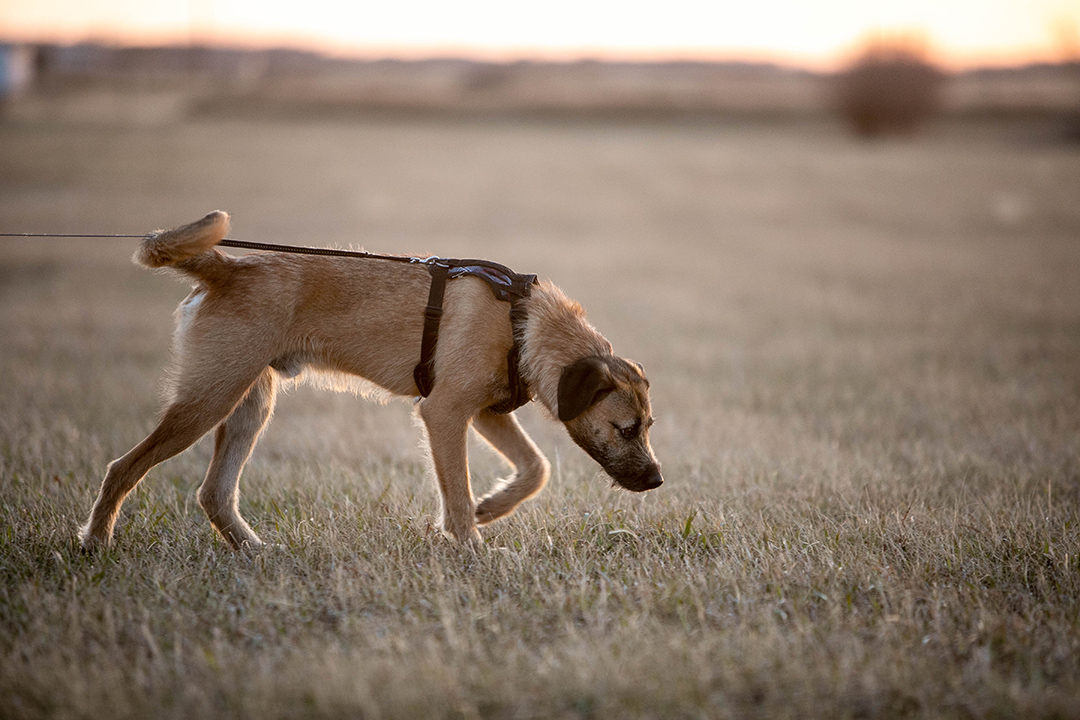
New diagnostic tools protect dogs and humans from deadly parasite
An emerging parasite known as Echinococcus multilocularis has been increasingly appearing in coyotes in Western Canada as well as in new regions of North America in recent years.
By Brooke KleiboerThis parasite poses a potential threat to the health of dogs and humans, said University of Saskatchewan (USask) graduate Dr. Temitope Kolapo (PhD).
The tapeworm can have a severe impact on dogs if they ingest the parasitic eggs and develop a condition known as alveolar echinococcosis (AE).
“These eggs are immediately infective and can survive for years in the environment," said Kolapo, who earned her PhD degree in veterinary microbiology from the Western College of Veterinary Medicine (WCVM) in February under the supervision of Dr. Emily Jenkins (DVM, PhD). “AE behaves like an invasive tumour disease and is very debilitating and costly to treat in both humans and dogs.”
In her recent study published in the journal Transboundary and Emerging Diseases, Kolapo showed that a diagnosis of AE in a dog in Western Canada can cost the owner over $10,000.
Kolapo said there has been an increase in the prevalence of E. multilocularis parasites in Western Canada in recent years, and thus, an increased risk of developing AE for both dogs and humans exists today. E. multilocularis adult parasites flourish in the intestines of dogs, coyotes, foxes and wolves that often pass eggs eaten by rodents; when dogs and humans accidentally consume these eggs, they are at risk of contracting the parasite. AE can develop in the liver, and if the disease goes undetected in the early stage, treatment options and outcomes are often poor.
With her PhD research, Kolapo developed new diagnostic tools for veterinarians to help diagnose both intestinal and liver stages of the parasite infection in dogs. These tools will allow for early detection and treatment of the parasite, which is key to the survival of exposed dogs.

Because the parasite and the development of AE can have such widespread effects, Kolapo engaged directly with communities that work with affected animals to participate in her research.
“My research relied heavily on the engagement of hunters, trappers, and provincial and territorial veterinarians for wildlife samples,” said Kolapo. “I also worked with infectious disease physicians, human health personnel and veterinarians and pathologists who volunteered information and samples for canine case studies.”
A team of former WCVM summer research students who were integral to Kolapo’s research include Sarah Revell, Mila Bassil, Joy Wu and Allison Hay.
The importance of the research — besides saving infected dogs — is also to better understand the potential risk for humans, including dog owners and clinicians who work with exposed dogs. This One Health research approach recognizes the interconnectedness of people, animals and the environment.
Kolapo said taking a One Health view of the research was crucial to its success.
“My research on AE in dogs is important from an animal health perspective and also from a human health perspective as infection in dogs serves as an indication of risk to humans,” said Kolapo.
Research results indicated that diagnostic tests can be designed to help clinicians catch and treat AE early. Kolapo was a coauthor on a publication in the prestigious Journal of Infectious Diseases describing that the first human AE case in Saskatchewan most likely came from infected wildlife or dogs in Western Canada.
“Already, tests that I have developed have been used to detect the first cases of dogs shedding eggs of the parasite in Western Canada, helping mitigate risk to their owners and to veterinary personnel,” said Kolapo.
Kolapo had the opportunity to give almost 10 presentations showcasing the results of her research, and published three academic papers.
In the future, Kolapo plans to continue taking her work to the next level in protecting animals and humans from these types of health risks.
“It is important to continue to get base line data on E. multilocularis in wildlife and domestic dogs in other regions of Canada,” she said. “This knowledge will aid in the formulation of prevention and control strategies. We also hope to continue to improve diagnostics as well as consider vaccine development.”
“I am excited to see what the future holds for me,” she said.
The research was funded by WCVM, Natural Sciences and Engineering Council of Canada, Mitacs Accelerate program, Aquila Diagnostics, United States National Center for Veterinary Parasitology, and the Wildlife Health Research Fund, with technical support from the Canadian Food Inspection Agency and Prairie Diagnostic Services.
This article first ran as part of the 2023 Young Innovators series, an initiative of the USask Research Profile and Impact office in partnership with the Saskatoon StarPhoenix.
Together, we will undertake the research the world needs. We invite you to join by supporting critical research at USask.
